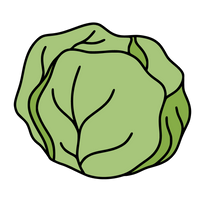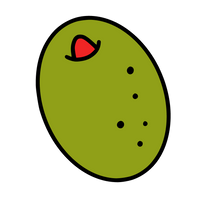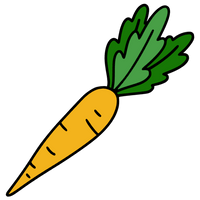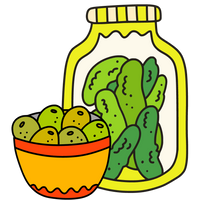
When it comes to eating for gut health, there are many strategies to take. And while there is no one-size-fits-all approach, there are some basic principles that apply.
Why you should eat more fiber.
One principle is to increase your dietary fiber intake. And while that's a generally good idea, the fiber conversation is actually a little more nuanced than that.
This article will break down the different types of dietary fiber and why they're essential for gut health.
Understanding the basics of dietary fiber intake is foundational for anyone seeking to improve gut health. Beyond gut health benefits, a diet with high fiber intake is associated with healthy aging; nutritional science backs that fiber helps lower the risk of cardiovascular disease, neurodegenerative diseases, and certain kinds of cancer. (1)
Let's get started and explore what is the best fiber for gut health.

What is fiber?
Fiber is a type of carbohydrate that the body cannot digest. Dietary fiber helps regulate the body's use of sugars, and it keeps hunger and blood sugar regulated.
How much fiber is best? Women need less fiber, around 21-25 grams per day, compared to men, who need daily between 30-38 grams per day.
Most Americans get less than half of these daily amounts, averaging 10-15 grams per day.
High fiber diet research is abundant, and higher fiber intake is shown to lower the risk of heart disease (1,2). Higher dietary fiber intake has also been linked to a lower risk of metabolic syndrome, that slew of symptoms that, when combined and stacked, are drivers of heart disease and diabetes. (3)
No doubt, dietary fiber is essential to your gut health and overall health. Let's discuss the different types of fiber.

What is soluble fiber?
Soluble fiber absorbs water and forms a gel. It expands and creates a feeling of fullness and satiety. Soluble fiber feeds the good bacteria that live in your large intestine. This gut bacteria collective is also called the gut microbiome, the vast colony of 'good guy' bacteria that live in your body, primarily in your gut.
Functioning more like a vital organ, the gut microbiome has core jobs of immune system regulation, appetite control, body weight moderation, and gut support (to name just a few.)
When gut bacteria consume soluble fiber, they produce butyrate, a short-chain fatty acid. Among short-chain fatty acids, butyrate has been most extensively studied. Some health benefits of butyrate? It's a gut health essential, as it helps to make energy for some of your gut cells to build your gut lining and prevents gut inflammation. (4)
What are some foods rich in soluble fiber?
Beans (black, lima, and kidney), seeds (flax, sunflower), fruits (apricots, apples, guavas, pears, and figs), and vegetables (avocado, carrots, Brussel sprouts, and cabbage.) Regarding beans and seeds as they relate to digestion, it’s important to prepare them properly before eating. Did you know that in all traditional diets, beans, seeds, and grains were always soaked before consumption? Soaking these foods makes them tender and easier to digest, increases beneficial enzyme production to aid in digestion and gut health, and helps reduce anti-nutrients that can be difficult for the body to break down.
What's the difference between soluble and insoluble fiber? Read on.

What is insoluble fiber?
Unlike soluble fiber, insoluble fiber does not dissolve in water or gastrointestinal fluids; it remains more or less unchanged as it moves through the digestive tract. Insoluble fiber "moves things along."
Because it's indigestible, insoluble fiber sits in the digestive tract absorbing fluid and sticking to other byproducts that are ready to be eliminated.
Its presence speeds up moving out this waste, helping prevent blockages and constipation.
A healthy diet contains a mix of both soluble and insoluble fiber.

What is Resistant Starch?
Starchy foods that are resistant to digestion are called resistant starches, and they function very similarly to soluble fiber. And just like soluble fiber, resistant starches, when fermented (or digested) by gut bacteria, create the byproduct of butyrate, the short-chain fatty acids with many gut health benefits. (5)

How food is prepared has an effect on the ultimate amount of resistant starch in food.
Resistant starch is found in potatoes and rice, which forms when cooked and cooled. The cooling turns some of the digestible starches into resistant starches via the process of retrogradation. (6)
"Starchy foods" have gotten a bad rap in the consumer world, primarily because of their high glycemic index. But as gut health science continues to develop and expand, the study of resistant starch and its many health benefits (7) might redeem starchy foods like potatoes and rice after all.

What are Prebiotics or Prebiotic Fiber?
You've heard of the benefits of eating probiotic foods, those foods that contain live cultures and enzymes. More recently, the term prebiotics has become popular.
In short, prebiotics are the fibers that feed your gut bacteria.
Scientists researching the value of prebiotics in treating diseases have more recently described a prebiotic this way:
A prebiotic is a partially digested ingredient that allows specific changes that confer health benefits to the host when ingested and digested by the gut microbiota.
Prebiotics are soluble fiber. This term has been coined in recent years in response to a new awareness of the microbiome and fiber's role in feeding the microbiome.
Although it's a helpful term to use in gut health conversations around the importance of fiber, the concept of prebiotics is not actually new.
Are there optimal prebiotic/high soluble fiber foods that are extra powerful at nourishing the gut microbiota?
Yes. High prebiotic foods include chicory root, dandelion greens, Jerusalem artichoke, garlic, onions, leeks, asparagus, bananas, barley, oats, apples, Konjac root, cocoa, burdock root, flax seeds, Yacon root, Jicama root, wheat bran, and seaweed.
TO BE PREBIOTIC, THE FOOD INGREDIENT MUST:
1. Resist digestion processes in the stomach and intestine
2. Be digestible (fermentable) by the gut microbiota
3. Stimulate the growth or activity of the intestinal microbiota
4. Confer a health benefit to the host

Prebiotics are fiber that the good bacteria in your gut eat and subsist on. (1)
Prebiotics lay the foundation for maximizing the benefits of probiotics. That's because prebiotics nourish and strengthen gut flora.
When it is strong and nourished, the gut microbiota can be ready to receive the full benefits of live cultures, probiotics, and enzymes from the fermented foods we eat. We like to think about the gut as house that needs painting: prebiotics are like the primer and probiotics are like the top coat.
Prebiotics and probiotics functioning in symbiosis will create a digestive environment that optimizes good health in the body.

How to Get More Prebiotic Foods in Your Diet
1. FIRST, EAT MORE PLANTS, WHICH HAVE A BENEFICIAL PREBIOTIC EFFECT.
Nutritionists have spoken of the need for fiber in a healthy diet for years. Dietary fiber is defined as "a carbohydrate that does not contribute much in the way of food energy (calories), even though it is often included in the calculation of total food energy just as though it were a sugar." (2)
Further contemporary research shows that although fiber may not translate directly into calories through our digestion processes, fiber provides a nutrient base for our gut flora to grow and thrive. (3)
2. LOOK FOR HIGH-FIBER OPPORTUNITIES WITHIN YOUR EXISTING DAILY HABITS.
If you start your day with a power smoothie, make sure it's fiber-rich (add some spinach leaves, half an avocado, or a scoop of fiber supplement).
If you prefer to juice, by all means, save that fiber to incorporate into soups which can be blended into a delicious veggie bisque to enjoy for lunch, alongside sauerkraut.
3. TO TAKE YOUR GUT HEALTH TO THE NEXT LEVEL, KNOW ABOUT THE PREBIOTIC SUPERFOODS.
These include chicory root, onions, garlic, oatmeal, asparagus, dandelion greens, Jerusalem artichoke, barley, and apples with skins.
4. EAT FOODS THAT PACK BOTH A PREBIOTIC AND A PROBIOTIC PUNCH.
If you guessed that the best ones are pickles, kraut, kimchi and olives, you guessed right.
By now, it's clear: it's not just about the probiotics. It's prebiotic fiber that is at the foundation of excellent gut health.

Probiotics and Postbiotics
It seems appropriate to review the topic of probiotics and postbiotics, since we're talking about prebiotics.
Probiotics are defined as beneficial organisms that confer a health benefit when consumed. Think live cultures, enzymes, yeasts, and our favorite: lactobacillus bacteria-- the kind of healthy bacteria created in the natural fermentation process.
Science is beginning to understand the gut microbiome's influential role in the body. Recent findings have proven the link between a diet full of probiotic fermented foods and improved immunity markers. (8)
What are postbiotics? This term refers to the waste left behind after your gut bacteria digests both prebiotics and probiotics. Bacteria poop if you will. Healthy postbiotics include nutrients such as vitamins B and K, amino acids, and substances called antimicrobial peptides that help to slow down the growth of harmful bacteria.
Other postbiotic substances are the short-chain fatty acids like butyrate that we already discussed, which offer a bevy of gut health benefits.

What is the best fiber for gut health?
Both soluble and insoluble fiber are found in most fruits and vegetables, nuts and seeds, and whole grains; the proportion of each will differ depending on the food. It's essential to get both kinds of fiber in your diet as they have a symbiotic relationship.
Soluble fiber feeds and nourishes the gut microbiome, producing short-chain fatty acid butyrate, which bolsters gut health. Insoluble fiber acts as a broom, sweeping through the digestive tract and keeping things moving.

Increasing dietary fiber intake
If you are looking to improve gut health by increasing your dietary fiber intake, that's good! However, you should introduce an increase in fiber slowly over time so that your body can adjust.
And it's important to note that drinking plenty of water, especially when increasing fiber quantity, is vital.
How much water should you drink daily? Current wisdom states to drink half an ounce for every pound of body weight. So a 150-pound individual should drink 75 ounces per day.
Obviously, this will vary based on lifestyle factors such as exercise level, so determine the right amount for you. And while you can increase fiber intake with a fiber supplement, most do not contain the additional vitamins and nutrients found in whole, fiber-rich foods. The best way to get prebiotics, probiotics, and postbiotics is to consume a plant-rich, whole foods diet.

Risks of too much fiber intake
Introducing too much fiber can create abdominal bloating, discomfort, and even diarrhea.
Again, if you want to increase your daily fiber intake, do it slowly over time.
The Link Between IBS, FODMAPs, and Fiber
One in seven adults suffer from IBS, Irritable Bowel Syndrome.
Symptoms of IBS may include chronic lower abdominal pain and discomfort, bloating, gas, distension, and irregular bowel habits.
What's frustrating for so many is determining the cause and triggers of these problems.
Researchers at Monash University identified FODMAPs as a trigger; FODMAPs are a collection of short-chain carbohydrates that aren't properly absorbed in the gut and cause or exacerbate many of the IBS symptoms. Monash has also identified low FODMAP foods and developed the low FODMAP diet (TM), which, when adhered to, can alleviate IBS suffering. (9)
A high fiber diet can be a challenge for those with IBS. Insoluble fiber may exacerbate IBS symptoms, and soluble and resistant starch may alleviate them.
Understanding the types of high fiber foods and their effects is part of managing IBS. These statements are general guidelines and not medical advice; consult with your care provider.
At Olive My Pickle we have many customers that suffer from IBS tell us that our fermented products are the first vegetables they've been able to eat in years, and that ferments help alleviate their symptoms.

The bottom line on Fiber
At Olive My Pickle, we're passionate about gut health. Because a high fiber diet plays an essential role in gut microbiome health, it's part of our ongoing conversations.
As fermented foods become more widely appreciated for their probiotic qualities, it's exciting to realize that they are also plant-based, high fiber foods and, therefore, prebiotic, probiotic, and postbiotic foods.
That makes fermented foods like pickles, kraut, kimchi, and olives some of the gut-healthiest foods.
Fermented Foods are both Prebiotic & Probiotic.
SOURCES
-
Pereira MA, O'Reilly E, Augustsson K, et al. Dietary fiber and risk of coronary heart disease: a pooled analysis of cohort studies. Arch Intern Med. 2004;164:370-6.
-
Rimm EB, Ascherio A, Giovannucci E, Spiegelman D, Stampfer MJ, Willett WC. Vegetable, fruit, and cereal fiber intake and risk of coronary heart disease among men. JAMA. 1996;275:447-51.
-
McKeown NM, Meigs JB, Liu S, Wilson PW, Jacques PF. Whole-grain intake is favorably associated with metabolic risk factors for type 2 diabetes and cardiovascular disease in the Framingham Offspring Study. Am J Clin Nutr. 2002;76:390-8.
-
https://www.sciencedirect.com/science/article/abs/pii/S0144861799001472
-
https://onlinelibrary.wiley.com/doi/full/10.1111/j.1467-3010.2005.00481.x








